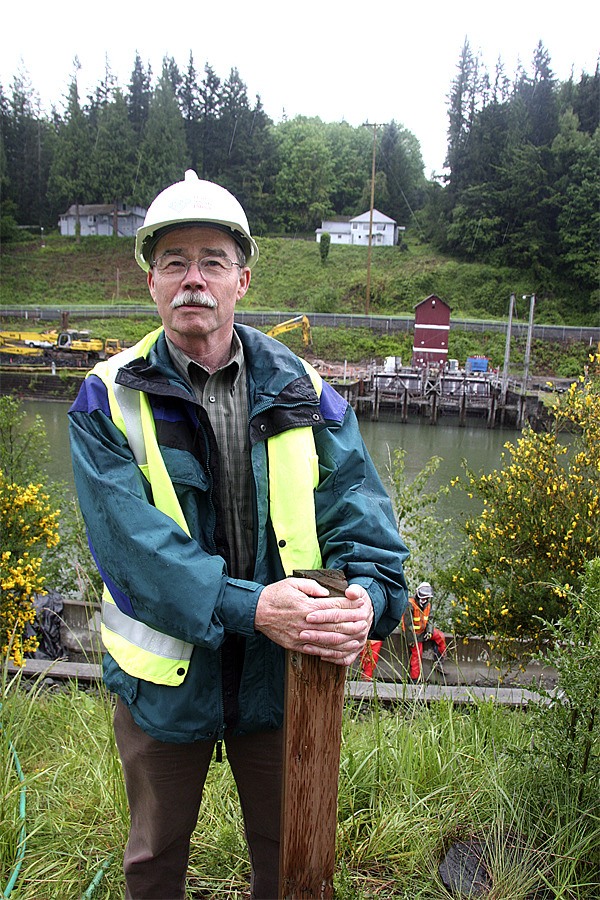Normally, the power generators at the Snoqualmie Falls hydroelectric plant run at a painful roar.
This summer, the machinery is silent for the first time in more than a century.
The silence is bittersweet for folks like Power Plant Manager Dave Magnuson, who has worked alongside mementos of history at the Puget Sound Energy-run site for two years.
“I never thought I’d forget that day,” he said when the generators 270 feet below the Falls were shut down.
Magnuson’s world is changing by the day. Underground and on the surface, changes are already evident in Puget Sound Energy’s three-year, multi-million-dollar update of the Falls parks and power plants, which is now going into high gear.
Works starts this month on the construction of coffer dams in the Snoqualmie River, needed to remove decaying, century-old rip-rap and fill material where the power station once stood. Workers with contractor Barnard Construction of Bozeman, Mont., will soon lower the diversion dam by two feet, changing flood levels both upstream and down.
After the Falls’ power plant 2 shuts down June 15, major construction will update generators in both plants. The upgrades add an additional 10 megawatts of generating capacity to the old 44-MW system, allowing the Falls facility to power about 40,000 homes.
Already gone are the pedestrian bridge and two crumbling service buildings visible from the Falls park — the tip of the iceberg compared with big changes underground.
Aboveground, the landscape is changing daily, as workers and big machines transform the landscape at both power plant intakes, removing fill and structures alike.
“Once it’s gone, you kind of accept it as the new picture,” Magnuson said.
However, the new picture is meant to be as close as possible to an older one, from the era before the Snoqualmie Falls hydropower facility was built.
Park changes
Changes at the surface of Plant 1, including fewer buildings and a more original riverbank, are meant to give the site a more natural look.
“Power facilities will be less noticeable to those enjoying Snoqualmie Falls,” said Paul Wiegand, PSE’s vice president for power generation.
Once work is finished, the entire park will get improved trails, picnic areas, fencing and lighting, interpretive signs and kiosks, and better riverfront access, with new parking and restrooms in the lower park.
Construction is mostly done at the upper Falls park and lookout. Now, work, and disruptions to visitors, shifts to the lower park. Safety requires closure of the river launch area until early 2013.
Right now, all that can be seen at the surface of plant one is the elevator shaft. Soon, the penstocks, or large water pipes, will be removed, and a crane will lift aging equipment out of the underground chamber.
“We’re digging up history,” Magnuson said. “Most of what’s down there is staying.”
Four of the original turbines will be preserved. Lines have been strung across the Snoqualmie to allow divers to build two coffer dams along the bank. PSE’s contractor will then remove the fill, widening the channel as much as 39 feet and allowing flood waters to pass more quickly over the cataract.
Flood impacts
With a wider channel and a two-foot-lower dam, the Falls project is expected to lower 100-year flood levels in the city of Snoqualmie by six to eight inches, according to U.S. Army Corps of Engineers data. PSE has predicted a quarter-inch rise in 100-year flood levels in the Lower Valley as a result of the work.
The Falls dam is about four feet tall on average, and about 15 feet tall at its tallest point.
Flood mitigation was requested by the city of Snoqualmie and mandated by the Federal Energy Regulatory Commission, which approved the project. Company officials said notification on the project was given to parties of record during the federal approval process several years ago, including the city of Carnation and King County.
Neighbors Against Flooding, a group of concerned Lower Valley residents, have opposed the lowering of the dam. Last year, members of the group called on Puget Sound Energy to back a new study on flood impacts.
As work begins, PSE spokesmen say that no new study is planned.
“We didn’t think that cost-wise, it made sense,” said Jason Van Nort, Government and Community Relations Manager for PSE.
Van Nort said PSE is working with King County Department of Natural Resources on possible mitigation efforts for Lower Valley residents, but said that any mitigation would have to be in keeping with impacts, which PSE believes are small.
PSE officials insist that the Falls dam is a diversion structure, not a flood control dam, where water goes over the falls or through the power plants — but very little stays behind.
“We recognize we are part of the community,” Van Nort said. “If there is a way that is consistent with our impact, we’ll do something. We’re keeping our options open.”



